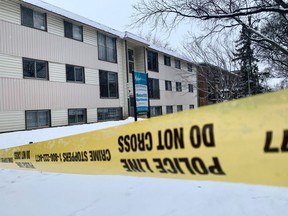
Article content
On Feb. 24, 2022, Edmonton police Chief Dale McFee announced that two civilians died during police response to a liquor store armed robbery. The suspect was one of those killed. Edmonton media reported that his firearm was fake. The second person was in his apartment and unconnected to the robbery — a tragic unwitting bystander. McFee’s demeanor demonstrated the mournfulness of the situation. The fatal shooting by police in Edmonton followed a Feb. 19 incident in Calgary, where police shot and killed Latjor Tuel, who had mental health issues. Tuel was carrying a wooden stick and a knife. TO CBCnewsreport notes that Tuel attacked a police dog at the scene.
advertisement 2
Article content
It is instructive that our focus has been on the conduct of officers in these two incidents rather than the suspects involved. Armed robbery is a crime in the Canadian Criminal Code but the punishment is not death by firearms. We all would have applauded the officers had they successfully arrested the suspect and allowed the law to take its course.
Instead, the police chief was put in an awkward position to explain to the public why one person robbed a liquor store but two people were dead. The matter boils down to careful assessment of a situation (sometimes a split-second decision to be fair), the level of threat encountered by officers and risk to the wider public. Were officers being shot at by the suspect? Were officers knowing that there could be others in the vicinity? Was there a need to respond with lethal force? This is about proportionality and reasonableness of use of force. Most police regulations and procedures recommend officers “may discharge their firearm if it is reasonable and necessary to do so.”
advertisement 3
Article content
An extra 10-minute verbal engagement with Tuel in Calgary might have saved his life and prevented further police excoriation. The innocent bystander in Edmonton might be alive today.
These incidents have wider implications. They erode trust and confidence in the police. For example, comparisons have been drawn with the “freedom blockade.” Heather Campbell, from the Calgary Police Commission, argues “How is it that we saw for three weeks people who outnumbered the police, who openly assaulted others, who were armed with weapons both visible and concealed, and police were able to bring the demonstration to conclusion without the discharge of a service weapon.’
Excellent candidates for police recruitment may look at use-of-force cases and decide the job is not for them if officers are regularly in the news for the wrong reason. That may contribute to having a concentration of individuals whose temperament is not suitable for law enforcement in a liberal democracy. They undo years of hard work involved in building ties with communities.
advertisement 4
Article content
Research on police use of force is quite fascinating. A small number of officers are responsible for a significant proportion of use-of-force incidents. They ratchet up poor disciplinary records while most of their peers may have no issues. One study finds that 5.4 per cent of officers were responsible for 32 to 40 per cent of all use-of-force incidents.
Such officers tend to be male, younger, on patrol in areas with higher rates of crime and work shifts around 3 pm to 11 pm and 7 pm to 3 am There is no consensus in the literature on the role of race although several studies suggest white male officers are more likely to be involved. Others see no link with race of officers. Years of experience do not appear to be a crucial variable in use or non-use of force.
advertisement 5
Article content
This means that a vast majority of officers deserve to not have their reputation impugned by the conduct of colleagues who are prone to excessive force. Therefore, the Alberta Serious Incident Response Team (AISRT) needs to ensure objective, thorough and transparent investigation so that the victims’ families receive justice for the death of their loved ones and serving police officers do not have to constantly deal with deviant peers who put the service into disrepute.
Officer misconduct, particularly in use of force, can ruin more careers than those of the individuals involved. Police chiefs have lost their positions due to the conduct of their officers. Elected leaders have also faced severe criticism and sagging popularity in some jurisdictions.
Surveillance of police practices is more expansive than ever before, as public expectations have shifted. Keeping errant officers in service makes policing more costly in financial and social terms. There is no need to throw the baby away with the bath water; the idea is to clinically separate the two. Excessively action-oriented police officers should be encouraged to consider special squads in the armed forces.
Temitope Oriola is professor of criminology at the University of Alberta. E-mail: [email protected] Twitter: @topeoriola